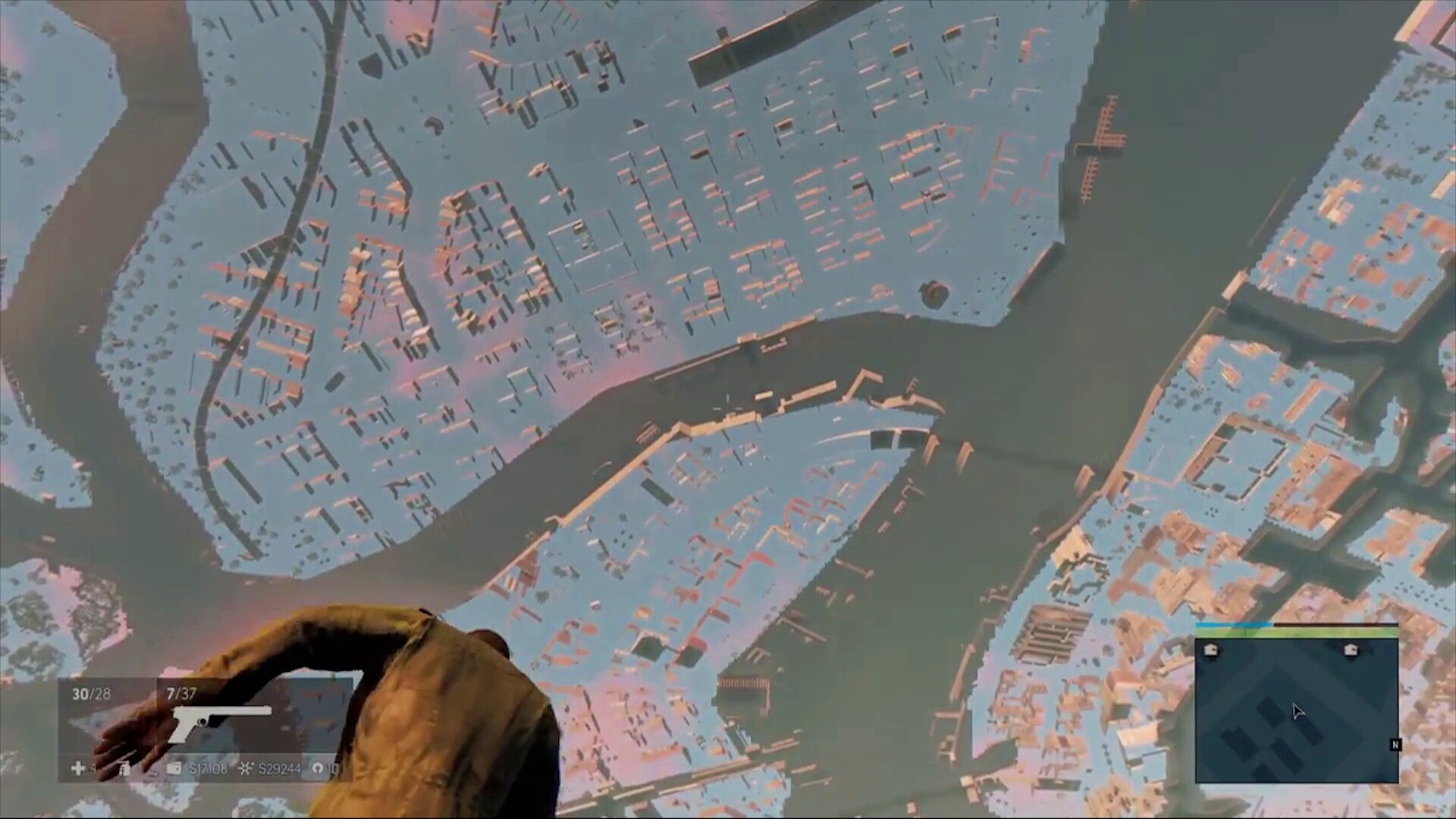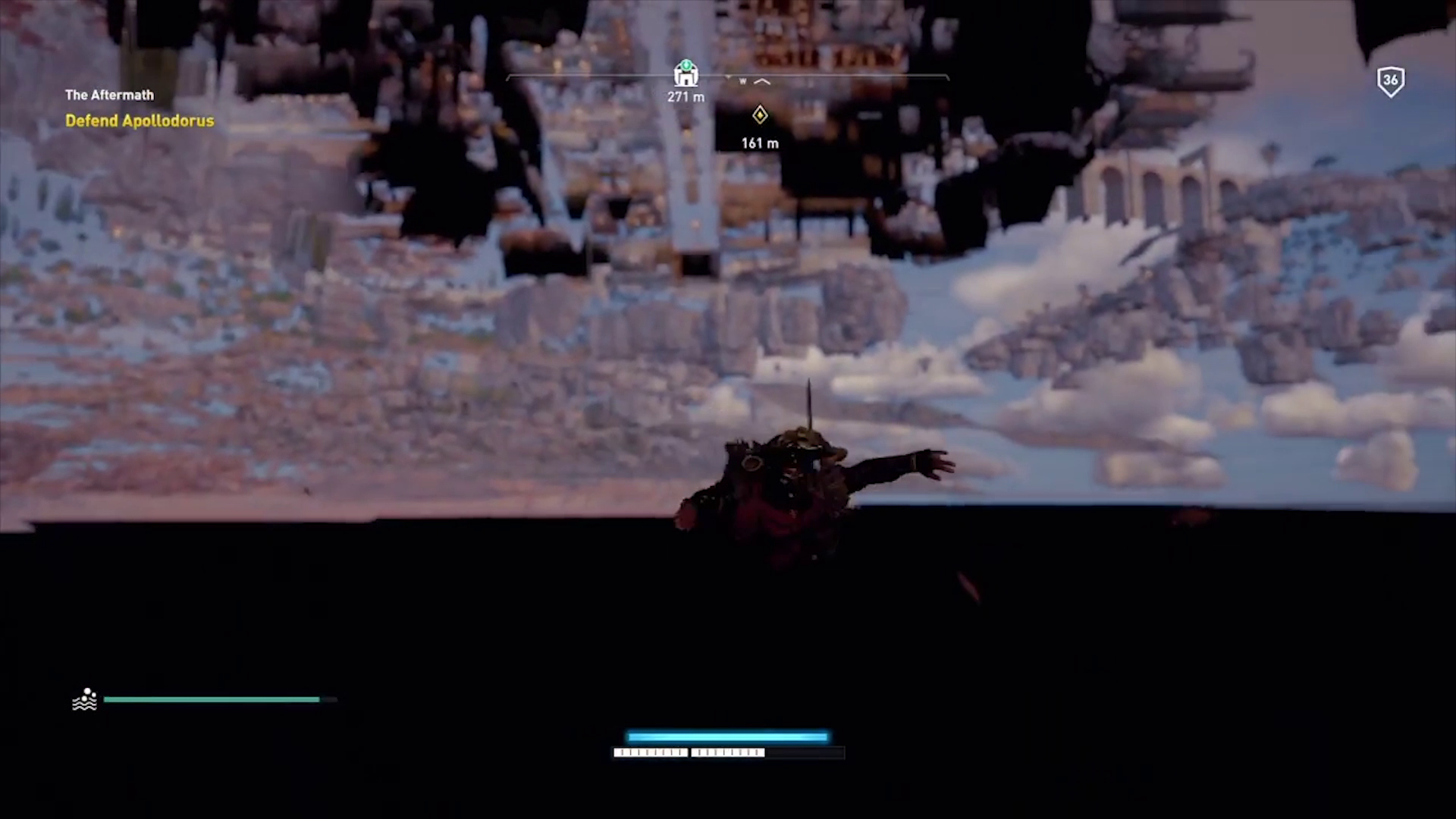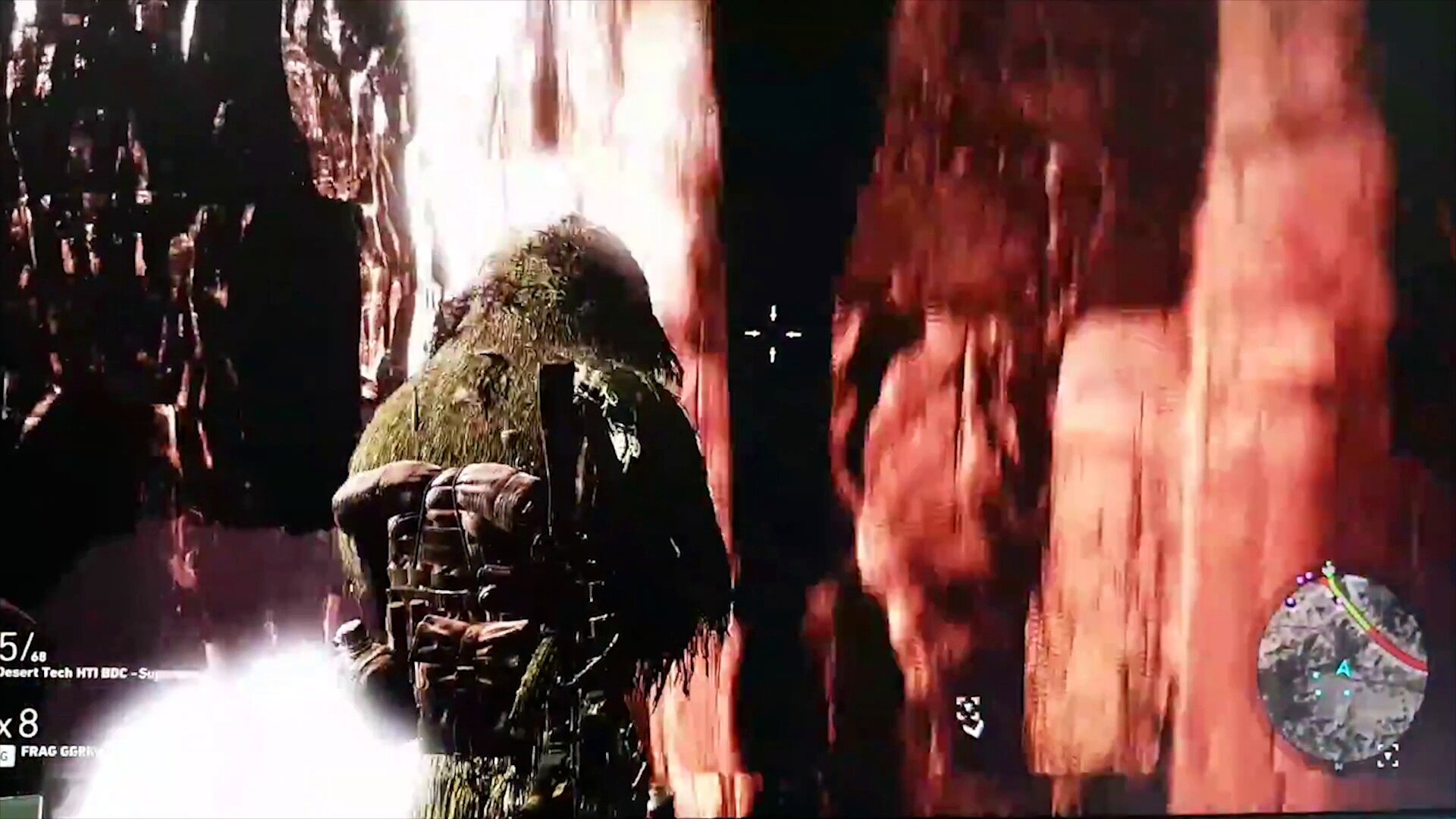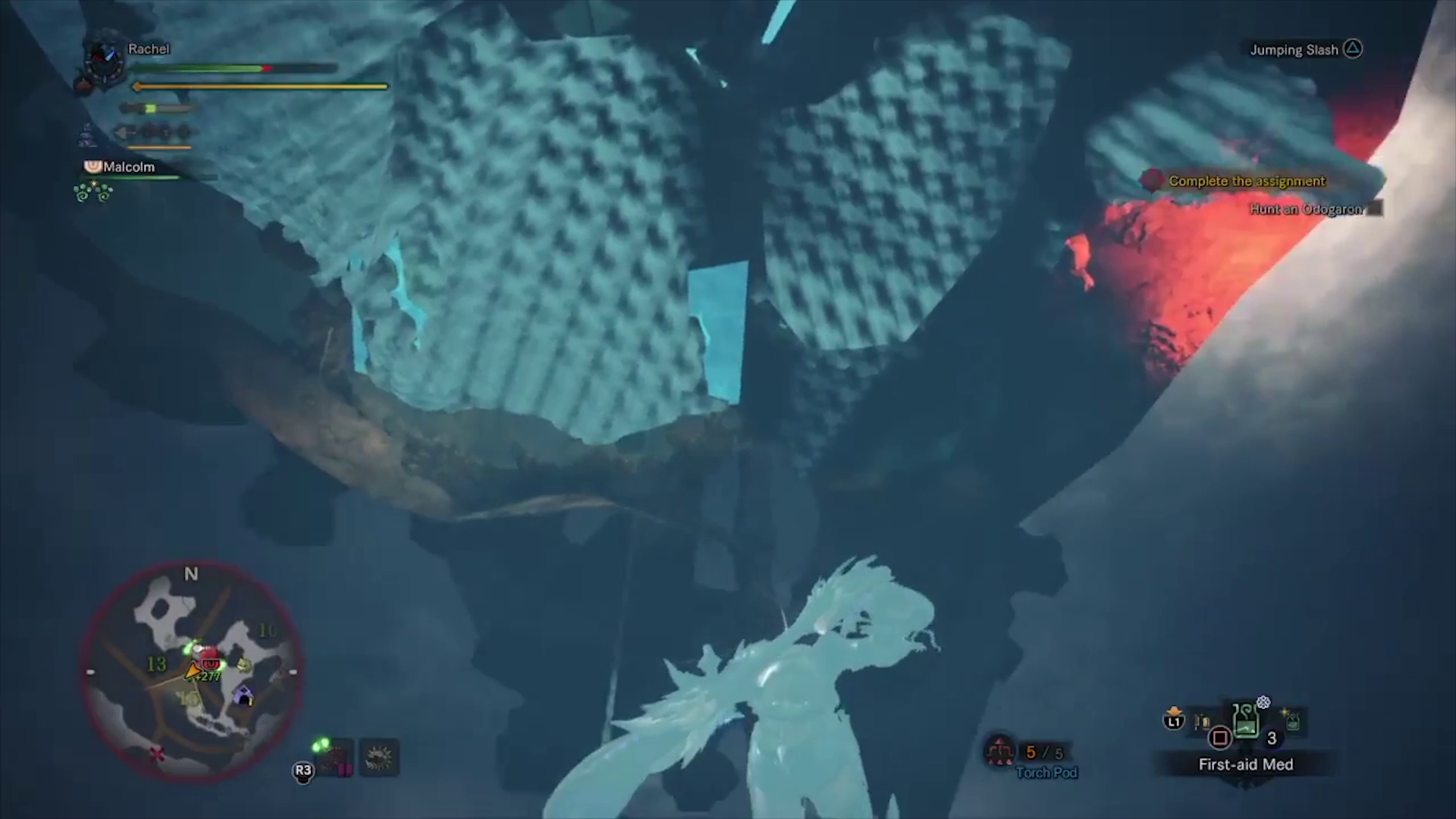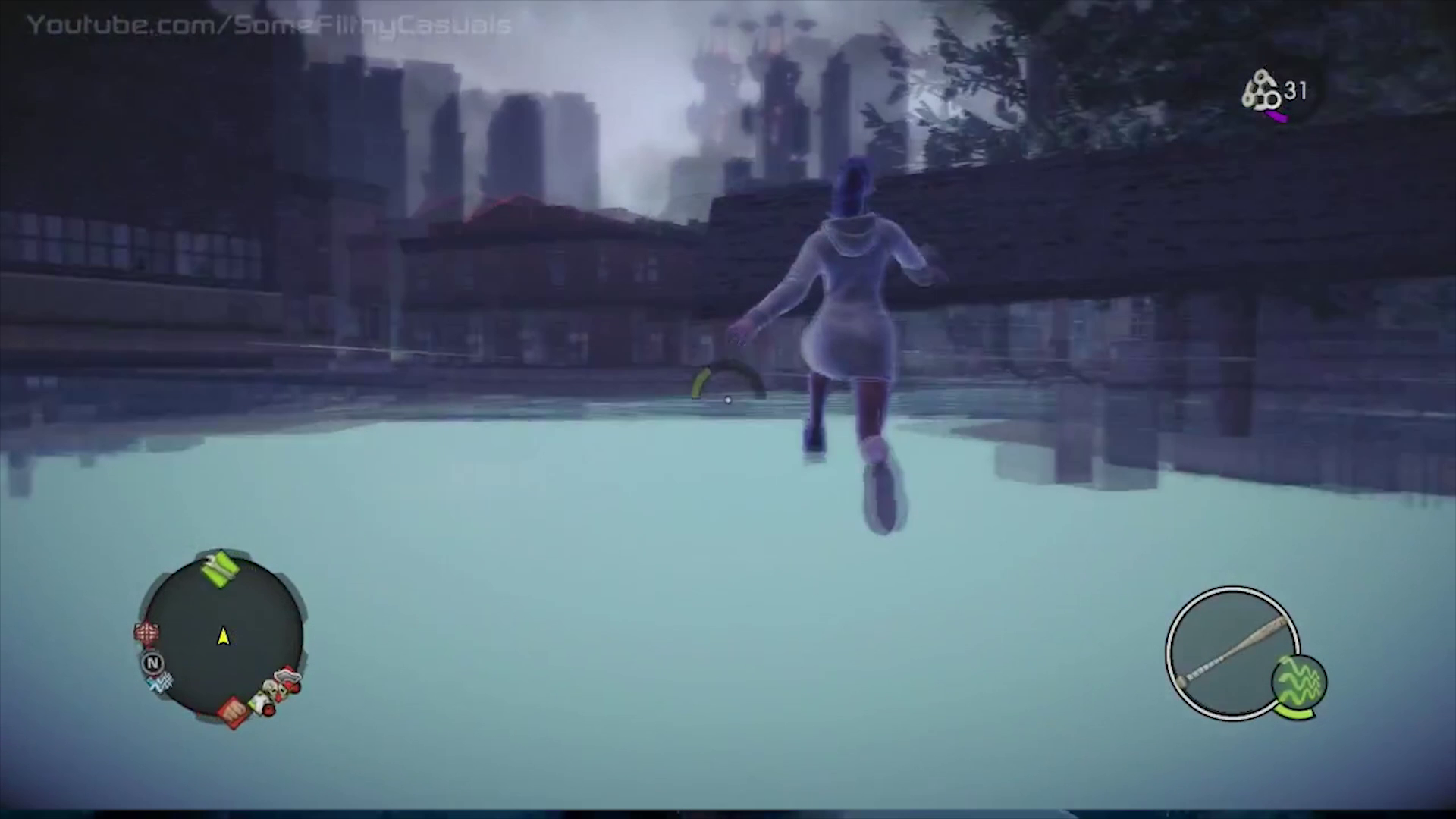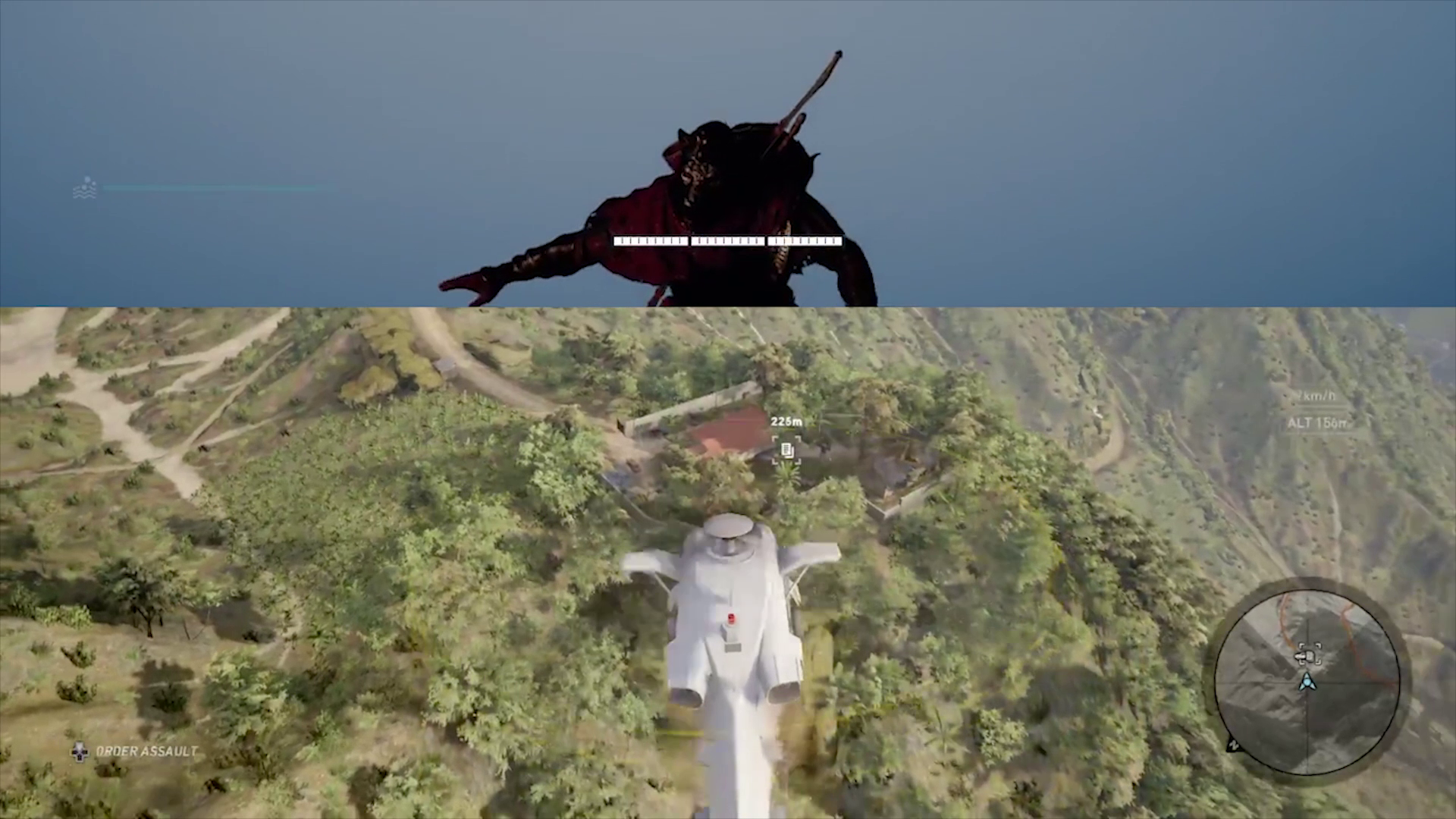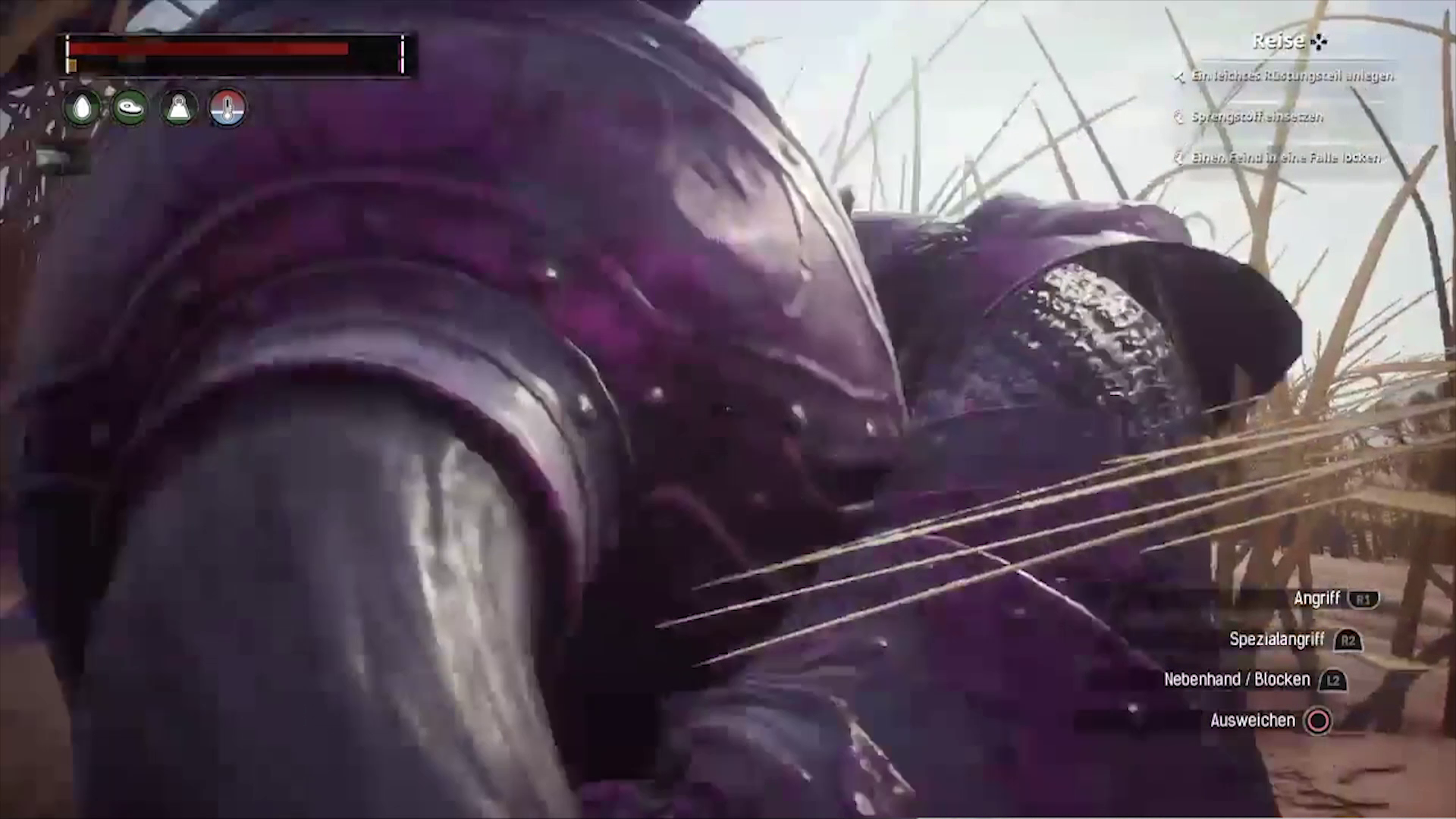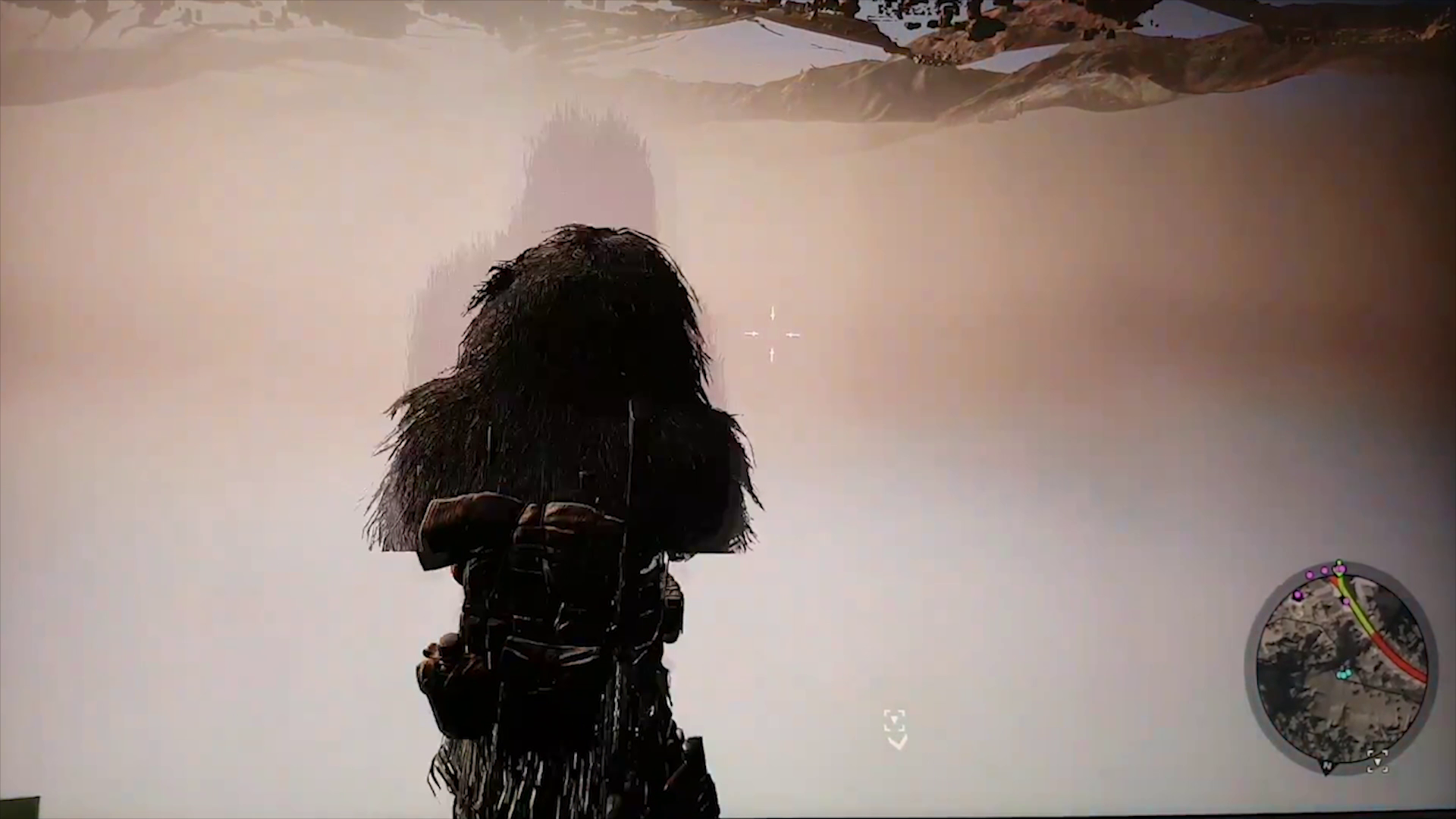FEATHERFALL
Digital video (1920 x 1080), color, sound, 10’ 21”, 2019, Austria
Created by Total Refusal (Robin Klengel, Leonhard Müllner, Michael Stumpf)
Originally conceived as a video installation, Featherfall is presented on VRAL as a single channel machinima. Adopting the format of the video essay, the project began as an investigation of the relationship between game playing and dreaming, a recurrent topic in video game forums. In their psychoanalytic examination sui generis, Austrian collective Total Refusal (Robin Klengel, Leonhard Müllner, Michael Stumpf) suggest that games and dreams have much in common. Featherfall focuses on the archetypal nightmare of falling, which in video games is often exacerbated by a recurring programming error otherwise known as a glitch which causes the player’s alter ego to suddenly disappear beneath the surface, plummeting into a void. This weird phenomenon is known to persist in the players’ subconscious and to resurface in their dreams, like a curse.
Total Refusal is Robin Klengel, Leonhard Müllner, and Michael Stumpf. In their practice, they critically analyze and appropriate digital game spaces and recontextualize them. Playing games but ignoring the intended gameplay, Total Refusal allocates these resources to new activities and narratives, in order to create “public” spaces imbued with critical, even subversive potential. Leonhard Müllner works as an artist in the public and digital space and is currently writing his doctoral thesis at the Linz Art University at the Institute for Art and Cultural Studies. Robin Klengel works in Graz and Vienna as an interdisciplinary artist, illustrator, cultural anthropologist and vice president of the Forum Stadtpark. Michael Stumpf studied philosophy at the University of Vienna and now is an artist, designer and cultural theorist.
Matteo Bittanti: Can you describe the process of creating Featherfall? How long did the pre-production and research stages take? How and why did you first become interested in video game players’s discussions of their dreams? Did you shoot the falling scenes from the twenty five games listed in the credits? If so, are these glitches “found” or “enacted”?
Total Refusal: One starting point for Featherfall was the simple experience of falling through the floor. It is actually a very banal phenomenon, which most gamers are familiar with due to the frequency of collision detection bugs. At the same time you can view it as an almost supernatural epiphany, a malfunction causing the game’s hyperrealism to shatter and allowing the player to see the game’s underworld: a scary and otherworldly experience.
It also resembles the archetypical nightmare of falling into an endless void. Most people experience a variation of that dream during their puberty and it is almost precisely mirrored in the video game cosmos: You are leaving the liveable world behind, traveling into a seemingly infinite abstract space. You are falling without ever arriving at the bottom. What a nightmare! It’s magical and terrifying at the same time. At one point we started collecting players’ experiences of that phenomenon and then decided to compose a found footage film from that material.
The other starting point is personal experience. Video games influence the dreaming patterns and content of most gamers, and that applies to us as well. Cyril, the protagonist in Antoine Chapon’s My Own Landscapes, who says: “Often I dream about what I saw in the video game. That’s normal, all players know that.” We’re like him. We got really interested in Jayne Isabel Gackenbach’s research suggesting that this influence is not necessarily a bad thing as games seem to have a complex effect on player’s dreaming behavior, an area that needs further investigation. Maybe it can actually help people to overcome their nightmares – just as described in the abovementioned film. We decided to collect some first hand data and started to look for forums’ threads of players discussing how they dream and what they dream of. We discovered quite a lot of material. Our research was limited in scope, yet it brought to the foreground interesting observations and we decided to collect them and create a video installation.
Matteo Bittanti: In his excellent book The PlayStation Dreamworld, Alfie Bown argues that video games display a dreamlike logic and thus psychoanalysis should replace conventional game studies as the best way to examine the medium. In your installation – which also functions as an eye opening video essay – you convincingly argue that this oneiric feature applies more to the game’s rules and mechanics, than their narratives. As gamification now pervades most aspects of “real” life, from education to business, would not be more appropriate to argue that reality itself now behaves more and more like a video game and thus we are all, in a sense, sleep walking?
Total Refusal: In his book Wir Untoten des Kapitals: Über politische Monster und einen grünen Sozialismus (We, the Living Death of Capital, 2020), Raul Zelik uses the metaphor of the zombie to argue that the “mechanics” embedded in Late Stage Capitalism transform people into subjects that are far more weak-willed and remotely controlled than they might think – without even realizing the state they are in. Zelik reminds us that the zombie first emerged in Haitian culture: he’s the victim of a mad wizard who controls him with voodoo magic. At the same time, the zombie is a metaphor for the slaves working on sugar farms under the most desperate conditions, deprived of their will. As neoliberalism – less violently but all the more effective – forces more and more people into humiliating labour and into a state of precarity – from the workers to the members of the socalled laptop-class to the CEOs – we have all become zombies, toiling away according to the neoliberal algorithm – quite similar to NPCs (non-playable characters) working in loops of endless pre-coded routines. To suppress disobedience, the monkeyshine of liberal ideology promotes the myth of freedom. Here, there’s a resemblance to open world video games, where we are promised the freedom to do what we want to do, while we actually just follow the game's rules and the developers’s intentions.
Our scope of action is narrowed, but at the same time, we feel the opposite. And here we get down to the nitty gritty: While hyper capitalist world machines per se, video games can grant gamers a limited space of emancipation in dreams. Instead of just being a zombie-NPC exposed to the plot of one’s own dream, the dreaming gamer can enjoy the sovereignty of his or her dream-avatar. This means that, on some levels, we can perhaps escape the sleep-walk-through of hyperrealism in late stage capitalism by immersing ourselves into our dreams. Yet, obviously, this all seems like blue sky-poetry, when we think about the fact that capitalism commodifies even our dreamlife.
Matteo Bittanti: The nightmarish fall is variously interpreted in psychoanalysis and it can refer to the sensation of falling asleep, a metaphor for the real risk of falling from bed, the repetition of traumatic experiences of falling or sensations of falling from parents’ arms in childhood, birth and delivery, ambition or the renouncement of responsibility, the loss of mental equilibrium, or life experiences such as flying in an airplane (I’m quoting from Wikipedia: the list is much longer). Interestingly, in most, if not all cases, falling is associated with fear, while ascension or flying with happiness. My question is: Is waking life “aspirational” while sleep is “realistic”, considering that environmental, social, cultural and economic collapse is accelerating at a global scale and at an accelerating pace? In other words, one may argue that fear is confined to dreams, while we should be terrified of the state of our planet. Instead, we wish to return to “normality” and purchase an SUV to feel “cool” and “powerful”...
Total Refusal: Recently Slavoj Zizek wrote that, today, “it is not simply that we don’t know what goes on, we know that we don’t know, and this not-knowing is itself a social fact, inscribed into how our institutions act.” A global answer to this uncertainty of current times is securitization. The whole world is reshaped in order to make sure a catastrophe cannot repeat itself. A single terrorist attack can start haunting a whole nation in the form of a collective nightmare. Suddenly an army of robocops seems not only necessary, but reasonable, evern urgent; bollards are erected on every town square in Ireland as a reaction to one horrible event in Germany. The gardens of kindergartens and elementary schools become cages to save children from... whatever. Adults become helicopter parents, preventing their children from experiencing the world. It seems to be the despair of preventing a situation from evolving in a potential future, that favours the preservation of the status quo and the circumvention of unpredictability. The “normality” is a narrative referring to a falsely neutral and apolitical status, which is, in fact, just the backside of the state of crisis. Crisis is, as we know not only from Marx, part of the algorithm of capitalism and police and surveillance terror are obviously the wrong answer to this instability. Globally, it seems our neoliberal governments are trying to stabilise our conditions of fear rather than tackling their root causes. No wonder they shine both through mass media products and the dreams we have.
One of us had a post game depression when returning to the real world after finishing Cyberpunk 2077. This is noteworthy insofar as the game depicts an ordoliberal dystopia, an exaggeration of our here and now referring to our current society, albeit in a highly aestheticized form. Like other entertainment media, video games have a way of making our problems consumable and aestheticised. In the game the violent police and the private guards as well as their antagonists serve as enjoyable obstacles. When we witness brutal or unfair outcomes of police violence and surveillance politics we can process these experiences in Cyberpunk 2077 by just fighting back. People escape into artificial stress to blur out the lack of perspective in tackling the physically real one.
Digital games take advantage of the player’s dangers and insecurities by transforming them into playable suspense. Nightmares develop their horrifying quality as the hidden and suppressed takes control, forcing a confrontation. Games and dreams can be quite alike in this processing of current problems - however, games can often also stage these confrontations while maintaining player control (or something that looks like it).
Matteo Bittanti: Yeah, the brain dances are quite a trip, but pretty much like everything in Cyberpunk 2077, they are recycled from elsewhere, specifically Kathryn Bigelow’s Strange Days (1995), which was used by Jay David Bolter and Richard Grusin as a paradigmatic example of the double logic of remediation, immediacy and hypermediation. Among other things, the American scholars argue that virtual reality is the medium that aspires to total and absolute immediacy, although its very materiality – a medium is, after all, the thing standing between things – makes that dream impossible to achieve, thus hypermediation is inevitable. This inner contradiction is perfectly illustrated in Joseph DeLappe’s Virtual Paintings (2018-). As artists and players, what is your take on virtual reality, both as a technology and as an ideology, considering that its biggest, er, evangelists are the likes of Palmer Luckey and Mark Zuckerberg?
Total Refusal: The digital experience is disguised in 3-dimensionality, but nevertheless, it is cursed to flatness and 2-dimensional devices. All its effort strives to liberate itself from 2-dimensionality, to trickle into 3-dimensional space and by doing so taking it over, dominating it. We already face a strong entanglement between these realities, which is why Stephan Schwingeler recently claimed that there often is little point in differentiating between physical and digital reality anymore. In the realms of communication, sociality, security, economy, para-economy (finance sector) and leisure digital and non-digital spaces are extensively interwoven so that a separation makes less and less sense. That, however, also means that the terror of hyperrealism is potentially unleashed. Its aesthetics hijacked our understanding via renderings, games, graphs, and simulations. It sounds counter-intuitive, but VR with its goggles seems to tame the digital imagery within the pandora box of the medium. It lurks like the demon in the flask, severely restricted by the technical limits and length of the cables.
The braindance of Cyberpunk is a different cup of tea: it’s an experimental sonic excursion undertaken by neural transmissions. Its physicality even puts the consumer at risk of intense bodily reaction, even death, in extreme cases. In that regard, it is quite close to dreams, where one can wake up in a wet bed or be scared to death or in love with someone one never has met. VR is closer to what we understand in the natural science of physics as a virtual image, which means the collection of focus points of light rays deriving from an object. If you compare VR goggles with those used for Cyberpunk’s braindances, you’ll notice that the former converts the digital into an analog signal – i.e. light – in order to be readable by the user, while the latter utilizes the user itself as an interface to interpret the digital information. In a way, DeLappe was right to associate VR googles with the ancient practice of painting.
Matteo Bittanti: “The whole world is reshaped in order to make sure a catastrophe cannot repeat itself” pretty much sums up Richard Grusin’s theory of premediation… On a similar note, in his latest book, 24/7: Late Capitalism and the End of Sleep, Jonathan Crary argues that capitalism is increasingly colonizing and exploiting sleep, one of the few remaining bastions that the neoliberal logic of maximization had not been able to completely conquer and exploit, “optimize it” and “maximize it”. However, as your project makes clear, this does not seem to be the case anymore. The video game imagery has fully penetrated into the subconscious and companies like Nintendo have long tried to monetize it. Considering how successful they were with Pokémon Go – perhaps one of the most paradigmatic examples of neoliberal gaming – it’s simply a matter of time before they turn our dreams into a golden goose, another raw material that “demands” intensive extraction. If that’s the case, will capitalism turn sleep into the same nightmare that is waking life in the 21c? Will gamification become the ultimate totalizing experience from which there’s no reset button?
Total Refusal: Yes. As you answered your excessively overloaded yet beautiful question yourself, we can just agree. In Cyberpunk 2077’s Night City, the NPCs can consume “Braindances”, which are basically what VR dreams of becoming one day. People sit inside bars or clubs, maybe intoxicated, and rent a virtual rendition of another person’s real life experience which completely infiltrates their consciousness. The black market provides the last minutes of someone getting tortured or killed for real (game-real) or one can feel how it’s like to get actually raped. Of course braindances mostly offer more convenient content. In Night City, the markets managed to dive into people's brains for the ultimate stimulation experience.
Watching Elon Musk proudly introduce his Neuralink chip, which not just reads neuronal activities in the brains of pigs but aims to also take control of brain activity in the future, it seems like the 1980s cyberpunk lore actually did a good job in predicting our here and now as well as our possible future. By the way: Musk's partner, pop star Grimes, actually plays a role in the game, motion captured for the narration. But to come back to your question: as capitalism seduces us with unsatisfiable desires it has colonized our dreams a long time ago – long before that supervillain Elon Musk tried it.
Matteo Bittanti: Although the two projects are completely unrelated – at least, I presume – Featherfall reminds me of Brody Condon’s seminal Suicide Solution (2004), a compilation of suicide scenes from several first- and third-person video games, perhaps because jumping into the void is often the most effective way of killing yourself, or perhaps because the very structure of Featherfall is similar to Suicide Solution’s (sans voice over). Sleep has been called la petite mort, the state or event resembling or prefiguring death: every night your experience and simultaneously exorcise dying. I argued elsewhere that one of the biggest appeals of video games is that they grant players the ability to simultaneously experience and exorcise (some kind of) dying. Thus, dreaming about falling in video games seems like a killer kombo to me, a double exorcism, a Christopher Nolan-like gimmick… Am I completely off?
Total Refusal: The question of death in video games opens the door to a whole theoretical universe. We could talk about the phenomenon of “permadeath”, for instance, whereby the player must restart the game from scratch if his or her avatar dies. It is the attempt to break with the commonness of the death experience in video games, replacing meaninglessness with severity. The oblivion of permadeath renders “a genuinely new vision of sublime experience”, as Filippo Lorenzin writes in his article Arcadian Dreams: AI-Generated Worlds from the Sublime to the Beautiful in Flash Art. The fear of losing everything causes a terror which is the “ruling principle” of the sublime, as he points out in reference to Edmund Burke. Death is almost fetishisized in this context.
Permadeath contrasts the obvious normalization of death in most games, as dying is exercised over and over again and has almost no noteworthy consequences. Does that confront us with mortality and prepare us for our own departure? Not at all, as it is normalized to an absurd degree, which is hardly experienced as a meaningful phenomenon: A visualization for failure, an exaggerated image that only insufficiently connects the player to any existential question. One of our new comrades in our collective Total Refusal, Adrian Jonas Haim, is currently working on a project dealing with the abundance of his avatar’s death experiences in Counter-Strike. He died many thousand times during his career. If you were to sum up the total time he watched his own dying animations, it would amount to almost a full working day of watching.
Susanna Flock, another comrade in our circle, created the work W-A-S-D (2015), for which she asked different professionals to reenact dying performances in various games: a dancer, a sportsman, a stuntman and a gamer. It is some sort of dying karaoke, posing the question “what death means in a digital reality and with which methods the concept of infinity is affected by digital culture”. It is a very fascinating topic indeed.
For Featherfall, however, death was not the central theme for us. Rather, we wanted to link the supernatural with the banal and the hyperreal with its own “other” – the mechanics of the hidden framework: the motif of falling and thereby falling out of digital normality.
Matteo Bittanti: Moreover, Featherfall reminds me of Cory Arcangel and Paper Rad’s Super Mario Movie (2005), a Super Mario Bros. cartridge for the Nintendo Entertainment System that the artists reprogrammed to play a movie which opens with the eponymous plumber falling from the sky for almost thirty seconds after standing for a while on a platform and looking left and right. The entire film — which Arcangel calls a “semi-narrative” — is meant as a dream, Mario’s dream. Mario dreams of a world ravaged by glitches, a world that is literally collapsing, falling apart because the “game is getting old” and its “internal logic” is deteriorating. In its own ways, is Featherfall as an homage, a remake, or an update to Super Mario Movie?
Total Refusal: No ^^
Matteo Bittanti: Well, I had to ask… You highlight the fact that dreams can be compared to third-person view video games. However, in conventional dreaming, the dreamer is unable to control the narrative, so to speak, and is subjected to someone else’s script. This is why dreaming has been compared to cinema: Hollywood as the ultimate dream factory. What role do agency and interaction play in the video-game-as-a-dream analogy? Are agency and interaction limited only to lucid dreaming, when the dreamer becomes aware that they are dreaming and can influence the unfolding of “events”? Was this a major theme that you encountered in the forums you explored, that is, the video-game-as-a-lucid-dream analogy?
Total Refusal: Cinema corresponding to dreaming/gaming corresponding to lucid dreaming: that sounds like a legit metaphor. And yet, the agency experienced in video games is, of course, an illusion stemming from the hyperreal fidelity of virtual worlds. When it works, one might feel as if it would have been possible to act out any given situation in a different manner. When the illusion of agency fails, the player is relegated to the position of the audience and the identification with the avatar is interrupted. In such situations, it can be quite uncanny to experience one’s representation in the digital realm behave in unexpected or undesirable ways; exposing the limits of player agency. Dreams usually fare better in this regard, because even though one might feel as an observer of oneself at times, the identification with this self is never severed.
It’s also worth pointing out that the opposition between agency and fidelity has always been a topic in game development. The latter taking the place of player imagination (when compared to the tabletop forebears video games evolved from); immersion is facilitated not through creative power but rather through the visual spectacle. The technical demands of this spectacle come at the cost of a narrowed scope of action.
Matteo Bittanti: If dreams are “better games” indeed, can we legitimately expect a Dreamscape-like scenario any time soon? In this, admittedly so-bad-it’s-good 1984 sci-fi movie directed by Joseph Ruben, Alex Gardner (Dennis Quaid) is coerced into joining a government project in which psychics like him are trained to enter others’ dreams for nefarious purposes. Basically, this technology allows the hacker to intrude the minds of others by projecting themselves into their subconscious, which is pretty much how advertising and propaganda work by the way. Considering that video games are the byproduct of the military-industrial complex, I would not be surprised if such a scenario will materialize… Oh, wait… Am I being too conspiratorial?
Total Refusal: When it comes to the reproduction of hegemonial values, mainstream video games don’t seem that different from their film equivalents. In both cases, the presence of political symbols aren’t necessarily an indication of political discourse. This is evident when developers operate with political content while at the same time denying the political nature of their work; arguing for games as a sort of pristine politics-free playground. This seemingly schizophrenic position is explained by the fact that the inclusion of political content is regularly not politically driven, but entirely motivated by marketing research. This marketing-based approach has, for example, lead publishers to include female avatars into their games – something long overdue, of course – in the wake of an identity politics culture wars, only to then maintain that their decision wasn’t political when faced with criticism from the right-wing spectrum of the gaming community – with the absurd thing being that at least partly, this claim is true: Their motivation in fact wasn’t political at all. It’s pure marketing.
Of course, all this doesn’t change the political power of games: Like other mainstream media and arguably even representative politics as a whole, politics are simulated but have long been replaced by market-logic – either to facilitate sales and/or to reinforce ideological constructs.
Matteo Bittanti: The interminable falling of the avatar in a video game is often the result of a glitch. One IRL equivalent of a glitch, per The Matrix, is the deja vu, the feeling that one has lived through the present situation before. In video games, the deja vu is experienced constantly, as the player repeats the same situations over and over. Would you agree that video games are deja vu simulators? Or are they closer to a modern day Fort/Da [Forth/here] game that was played by Freud's grandson, who would stage and re-stage the disappearance of his mother and even himself to reassure itself that he had some kind of control over his life? In the first case, video games are basically about trial and error. In the second case, video games operate as some kind of safety blanket or a transitional object, to paraphrase (and likely misinterpret) Donald Winnicott…
Total Refusal: It’s a beautiful term, but strictly speaking, calling video games deja vu simulators seems imprecise insofar as the deja vu constitutes itself through the uncanniness of the exact replication of a pre experienced event – something that doesn’t occur any more often (or even less often) in video games when compared to the real world. That’s not to say that repetition isn’t a core component of playing video games, of course. Both your assessments of video games as repeated trial and error and as safe zones are valid here: Controlled repetition constitutes a space of comfort and familiarity with the environment and, in a symbiotic sense, the avatar, a setting within which grave challenges can be attempted repeatedly with no harm done.
Matteo Bittanti: Just a few years ago, German director Werner Herzog famously asked: “Does the internet dream of itself?”. Google engineer Alexander Mordvintsev’s answer was DeepDream, “a computer vision program which uses a convolutional neural network to find and enhance patterns in images via algorithmic pareidolia, thus creating a dream-like hallucinogenic appearance in the deliberately over-processed image”, again quoting from Wikipedia verbatim because I am too lazy to apply rogeting. My question is: What do video games dream of? Can we think of machinima as video games’ own oneiric visions?
Total Refusal: All code based entities have a visual surface, an interface, as well as the concealed and invisible mechanisms constructing it: just like a frontstage and a backstage. We can very well anthropomorphize that relation to the conscious and the subconscious aspects of the human neural apparatus. While dreaming, the boundary between these two worlds blurs and it becomes difficult to differentiate between them. A glitch triggers a similar function in the game involuntarily, as these two worlds can, for a moment, touch. That resembles taking drugs or falling into trance. Players – particularly speedrunners, for instance – are always interested in accessing the backstages and search actively for loopholes to what could be coined as the “unconscious” of the game. Modders often do the same thing by permitting access to unapproachable parts of the code.
In a way, in our own work we follow the same approach. To deconstruct the virtual enchantment and especially its seemingly neutral but in fact very political nature. What appears to be a seamless, innocent, aesthetically optimized reality is just the frontend of a very complex technocultural construct. Making a machinima implies, in that case, also unleashing the medium’s dreams and nightmares and taking the viewer to a game's shady shoals and uncanny valleys.
Alternatively, to take a more literal approach to your question and think about the absence of the player – and thus the visual representation of the game world – as a game’s dream state. In that case, its subconscious activity consists of constant sensory activity in expectancy of the player – a longing almost – as well as the incessant bare-bones simulation of the world without any audiovisual representation – a phantasmatic as-if-image of the world.
Matteo Bittanti: Is there anything else you’d like to add?
Total Refusal: Hahaha. No, we’re good.
Featherfall
Digital video (1920 x 1080), color, sound, 10’ 21”, 2019 (Austria)
[video installation: 4 channel video installation (loop) + audio, loudspeaker]
Created by Total Refusal (Robin Klengel, Leonhard Müllner, Michael Stumpf), 2019
Courtesy of Total Refusal (Robin Klengel, Leonhard Müllner, Michael Stumpf), 2021
Text: Robin Klengel
Editing: Leonhard Müllner
Narration: Kate Howlett-Jones, Michael Howlett


